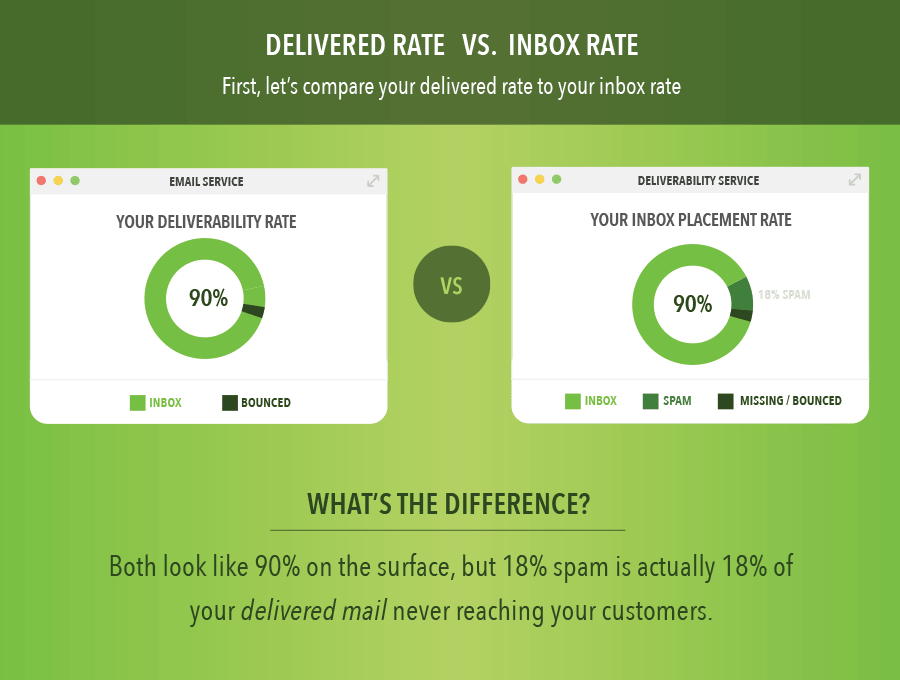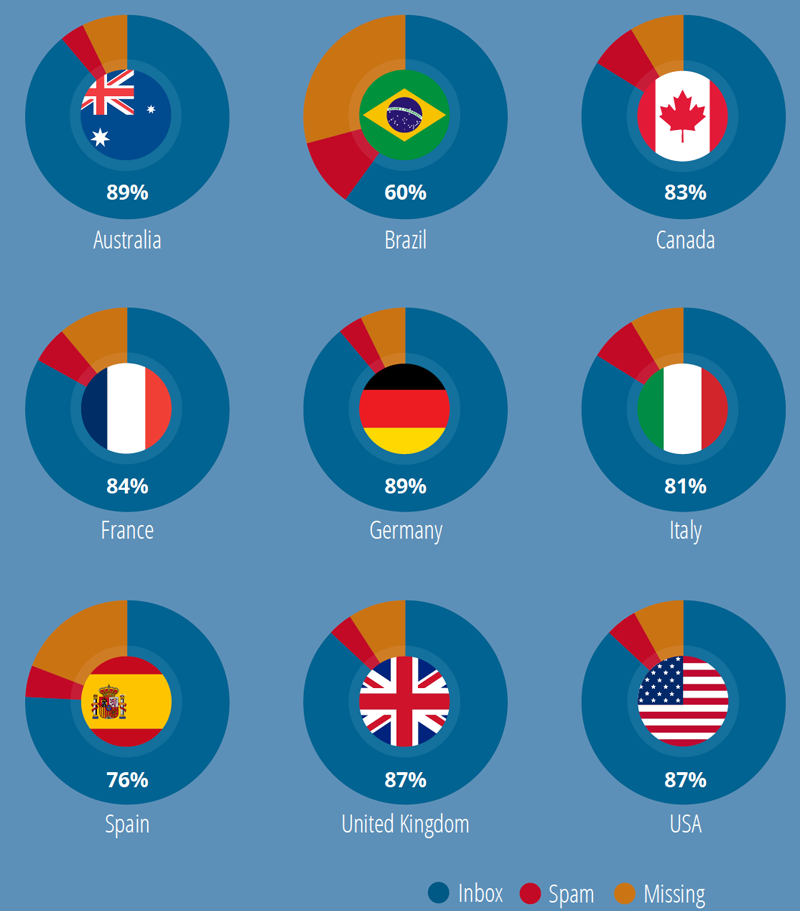Here’s a scary statistic: “Only 28% of all messages sent worldwide ever reach the inbox.” That’s according to Return Path’s 2014 Sender Score Benchmark Report. Fortunately, those of us in North America do far better than the worldwide average. Of permission-based emails sent from North America, only one in six messages fails to reach the inbox. That’s better, but still troubling.
At first, both of those statistics sound like a problem with email deliverability. But actually the problem lies with inbox placement.
Here’s why: “Deliverability rate” refers to the percentage of your emails that are delivered to your subscribers, but “delivered” also includes emails sent to the spam or bulk folder.
It ends up that “deliverability rate” metric we all thought we knew so well – doesn’t specify how many of those “delivered” emails make it to the inbox. If an email makes it through all the servers, and past the ISP filters, doesn’t bounce, and finally reaches the subscriber’s email account, it’s “delivered”. “Delivered” does not specify which folder the email ends up in.
Here’s how the deliverability service 250K.com explains this lesser-known aspect of deliverability rate. The graphic below is from in their recent infographic, “Deliverability Myth: Why You Need to Measure Inbox Placement”
Still trying to get your head around this? Here’s how the Internet Advertising Bureau explains the situation in their definition of “Email Delivered”:
This metric attempts to answer the question, “How many valid Email addresses actually accepted my complete message?” In other words, it describes how many were completely transferred to the intended recipient’s mailbox provider without generating a “bounce” or other delivery error. This metric is calculated before the impact of content-based filtering is factored in.
If a message is rejected by the mailbox provider, it does not count as delivered. However, if the message is accepted and placed in a “junk Email” folder it generally does count as delivered.
I’ve added the bold for emphasis there.
Here are two more email marketing authorities explaining this foible of deliverability rate:
• From Return Path describing how mail can be shown as being delivered without ever making the inbox:
“Determining inbox placement is more challenging than most marketers think because receiving mail servers will frequently indicate that mail has been delivered, when it has not actually been placed in the inbox.”
• From The UK digital marketing firm Communicator, describing how deliverability rate includes bulk folder placements:
“In a nutshell, inbox placement is the true measure of how many of your emails have made it to the inbox. It differs from the delivery rate as it just focuses on the inbox and ignores things like emails delivered to the junk folder, which delivery rate takes into account.”
Inbox placement is the metric to track
This secret about email deliverability including bulk folder placements is not widely talked about in email marketing circles. I’ve even run into a few email deliverability professionals who insist that deliverability rates do not include emails delivered to the bulk folder. They say email counted as “spam” as not included in deliverability rates. But they are. You just read the quotes, from two deliverability companies, an email agency and an industry organization. Those are just a selection of the many sources in the email industry who are starting to talk about this.
So what does all this mean? It means that while deliverability is important, it’s inbox placement that we all should be focused on.
What does “delivered” mean, exactly?
As you probably know already, “delivered” emails are emails that just didn’t bounce, get lost, or get filtered out by blacklists. They made it to the subscriber’s account.
What a lot of us might not know (and I didn’t know until recently) was that those “delivered” emails might also have been sent to the spam folder.
Another way to look at the consequences of this is that we shouldn’t be aiming for a 100% deliverability rate. The ideal email deliverability rate would actually include some spam folder placements. What we really want is a 100% inbox placement rate.
Inbox placement versus email deliverability
Inbox placement is a sister term to email deliverability, but it specifically refers to the emails that reach the inbox. That’s the metric we want.
The post 10 Myths for Inbox Deliverability from ClickZ, explains:
“Reports showing high “delivered” rates mean my messages reach the inbox. This is such an unfortunate language barrier. “Delivered” for most reports is simply a measure of the bounce rate. Inbox placement (or inbox deliverability) is a different number and reflects what percentage actually reaches the inbox. In addition, don’t be salved by average inbox placement across all clients of your broadcast vendor. Be sure you know this number for your own campaigns.”
For another perspective on the differences between inbox placement verses email deliverability metrics, check this video-taped discussion from Newfangled.com. It goes into depth about the differences between deliverability and inbox placement. Here’s just part of the conversation:
Lauren: … So a great deliverability rate isn’t necessarily the be-all end-all, right? Because you’ve got to be thinking about where those messages are landing actually in the inbox, so that they’re actually being seen.
Chris: Right and even we run into issues now, like with Gmail and their different tabs. In Gmail’s inbox, it can be placed in the inbox, but in the promotions tab.
Lauren: Right, absolutely.
Chris: But understanding that, yes, 98 percent of my email is being delivered, but we’re only getting 70 percent inbox placement. That means you probably have some things you can work on.
Inbox placement, bulk folders, and missing emails
So is this really that much of a big deal? It depends where you live, or more accurately, where you mail from. Check out the infographic below. It shows worldwide deliverability rates for inbox placement, emails sent to the spam folder, and missing emails:
The ultimate goal of improving email deliverability is basically to make all those circles solid blue – to get every single email delivered to the inbox. We may never get to perfection, but as the ISPs (Internet Service Providers) continue to evolve, hopefully they’ll let our emails through and manage to stay one step ahead of the spammers.









